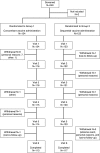Results from a randomized clinical trial of coadministration of RotaTeq, a pentavalent rotavirus vaccine, and NeisVac-C, a meningococcal serogroup C conjugate vaccine
- PMID: 21389149
- PMCID: PMC3122533
- DOI: 10.1128/CVI.00437-10
Results from a randomized clinical trial of coadministration of RotaTeq, a pentavalent rotavirus vaccine, and NeisVac-C, a meningococcal serogroup C conjugate vaccine
Abstract
RotaTeq (Merck & Co. Inc./Sanofi Pasteur MSD) is a three-dose, oral pentavalent rotavirus vaccine for the immunization of infants from 6 weeks of age for the prevention of rotavirus gastroenteritis. The primary objective of the present trial was to demonstrate that RotaTeq can be coadministered with meningococcal serogroup C conjugate vaccine (MenCC; NeisVac-C; Baxter Healthcare) to healthy infants without impairing the protective immune responses to MenCC. This was an open-label, randomized, comparative study conducted in Finland. The study was designed to assess concomitant versus sequential administration of RotaTeq and MenCC on the immune response to both vaccines. Healthy infants (n = 247), aged 6 to 7 weeks, were recruited. Coadministration of MenCC with RotaTeq was noninferior to sequential administration for the seroprotection rate against meningococcal serogroup C (the proportion of infants with a serum bactericidal antibody titer using baby rabbit complement of ≥ 8 was 100% in both groups). The other responses to MenCC (titer of ≥ 1:128, ≥ 4-fold increase in titer, and geometric mean titers [GMTs]) and the responses to RotaTeq (IgA and SNA response to G1 to G4 and P1A[8], GMTs, and ≥ 3-fold increase in titer) were comparable between groups, including a ≥ 3-fold IgA increase in >96% of the infants in both groups. Concomitant administration of the first doses of MenCC, diphtheria and tetanus toxoids and acellular pertussis vaccine, inactivated poliovirus vaccine, and Haemophilus influenzae type b conjugate vaccine (DTaP-IPV-Hib), and RotaTeq was associated with a higher rate of vomiting and diarrhea than concomitant administration of MenCC and DTaP-IPV-Hib, but that was not observed after the second concomitant administration. The convenience of concomitant administration of RotaTeq and MenCC may, however, outweigh the additive effect of mostly mild adverse events reported after the individual administration of each vaccine. These results support the coadministration of RotaTeq and MenCC.
Trial registration: ClinicalTrials.gov NCT00443846.
Figures
References
-
- Block S. L., et al. 2007. Efficacy, immunogenicity, and safety of a pentavalent human-bovine (WC3) reassortant rotavirus vaccine at the end of shelf life. Pediatrics 119:11–18 - PubMed
-
- Ciarlet M., et al. 2009. Concomitant use of the 3-dose oral pentavalent rotavirus vaccine with a 3-dose primary vaccination course of a diphtheria-tetanus-acellular pertussis-hepatitis B-inactivated polio-Haemophilus influenzae type b vaccine: immunogenicity and reactogenicity. Pediatr. Infect. Dis. J. 28:177–181 - PubMed
-
- Ciarlet M., et al. 2008. Concomitant use of the oral pentavalent human-bovine reassortant rotavirus vaccine and oral poliovirus vaccine. Pediatr. Infect. Dis. J. 27:874–880 - PubMed
Publication types
MeSH terms
Substances
Associated data
LinkOut - more resources
Full Text Sources
Medical
Research Materials
Miscellaneous


